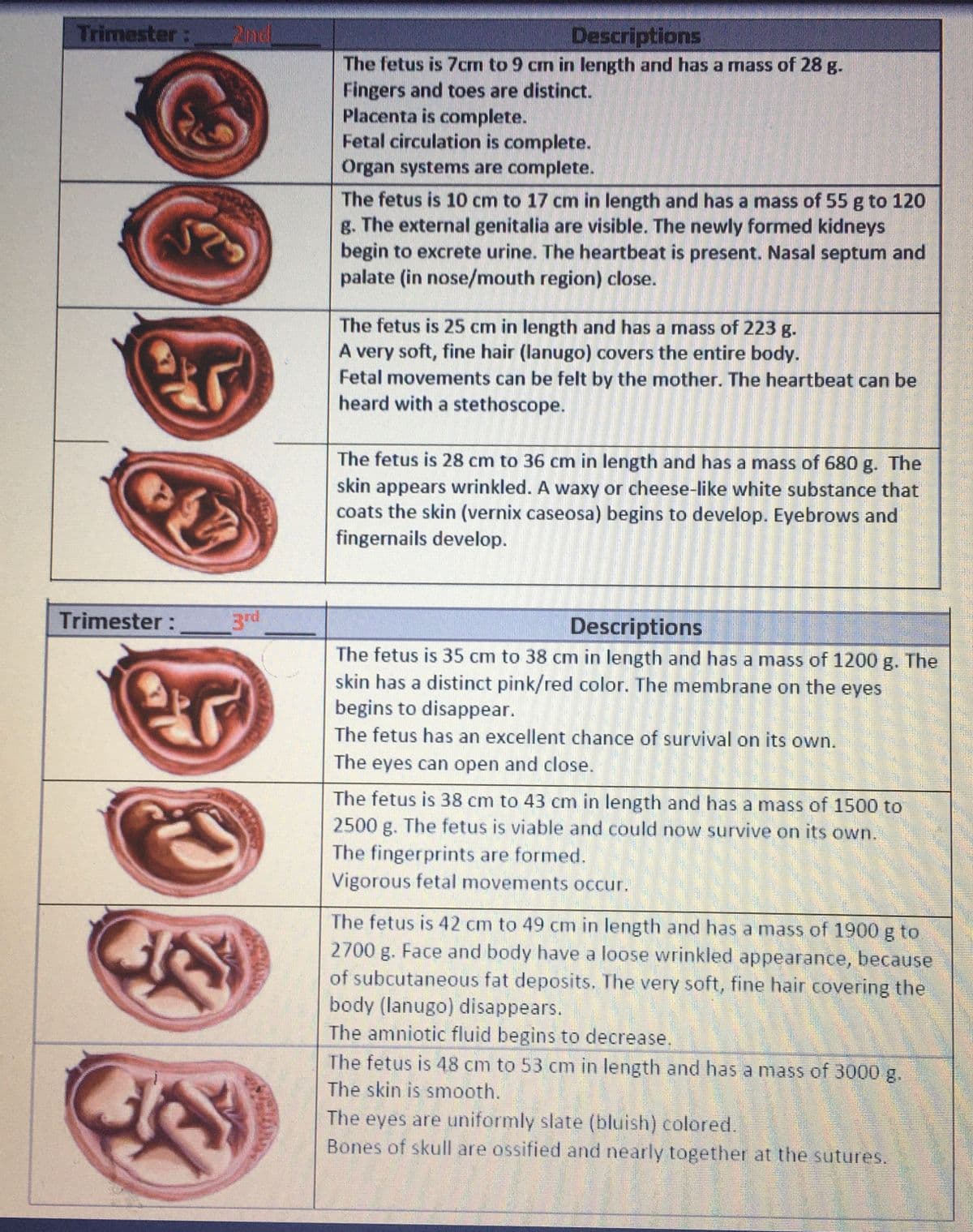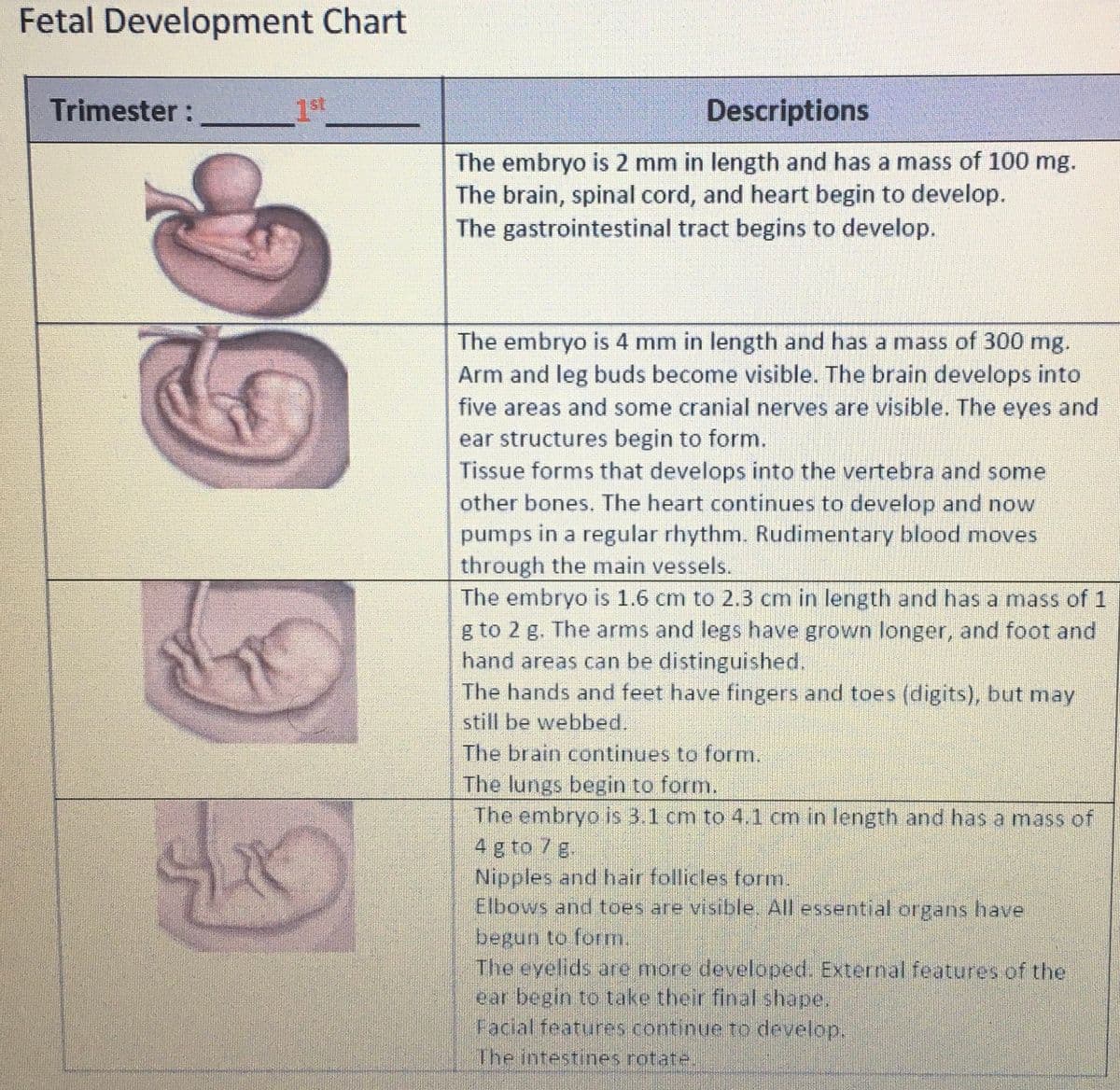Trimester: 2nd Trimester: Descriptions The fetus is 7cm to 9 cm in length and has a mass of 28 g. Fingers and toes are distinct. Placenta is complete. Fetal circulation is complete. Organ systems are complete. The fetus is 10 cm to 17 cm in length and has a mass of 55 g to 120 g. The external genitalia are visible. The newly formed kidneys begin to excrete urine. The heartbeat is present. Nasal septum and palate (in nose/mouth region) close. The fetus is 25 cm in length and has a mass of 223 g. A very soft, fine hair (lanugo) covers the entire body. Fetal movements can be felt by the mother. The heartbeat can be heard with a stethoscope. The fetus is 28 cm to 36 cm in length and has a mass of 680 g. The skin appears wrinkled. A waxy or cheese-like white substance that coats the skin (vernix caseosa) begins to develop. Eyebrows and fingernails develop. 3rd Descriptions The fetus is 35 cm to 38 cm in length and has a mass of 1200 g. The skin has a distinct pink/red color. The membrane on the eyes begins to disappear. The fetus has an excellent chance of survival on its own. The eyes can open and close. The fetus is 38 cm to 43 cm in length and has a mass of 1500 to 2500 g. The fetus is viable and could now survive on its own. The fingerprints are formed. Vigorous fetal movements occur. The fetus is 42 cm to 49 cm in length and has a mass of 1900 g to 2700 g. Face and body have a loose wrinkled appearance, because of subcutaneous fat deposits. The very soft, fine hair covering the body (lanugo) disappears. The amniotic fluid begins to decrease. The fetus is 48 cm to 53 cm in length and has a mass of 3000 g. The skin is smooth. The eyes are uniformly slate (bluish) colored. Bones of skull are ossified and nearly together at the sutures. E Fetal Development Chart Trimester: 1st Descriptions The embryo is 2 mm in length and has a mass of 100 mg. The brain, spinal cord, and heart begin to develop. The gastrointestinal tract begins to develop. The embryo is 4 mm in length and has a mass of 300 mg. Arm and leg buds become visible. The brain develops into five areas and some cranial nerves are visible. The eyes and ear structures begin to form. Tissue forms that develops into the vertebra and some other bones. The heart continues to develop and now pumps in a regular rhythm. Rudimentary blood moves through the main vessels. The embryo is 1.6 cm to 2.3 cm in length and has a mass of 1 g to 2 g. The arms and legs have grown longer, and foot and hand areas can be distinguished. The hands and feet have fingers and toes (digits), but may still be webbed. The brain continues to form. The lungs begin to form. The embryo is 3.1 cm to 4.1 cm in length and has a mass of 4 g to 7 g. Nipples and hair follicles form. Elbows and toes are visible. All essential organs have begun to form. The eyelids are more developed. External features of the ear begin to take their final shape. Facial features continue to develop. The intestines rotate.
Ultrasound Case Studies: Review the 4 case studies and determine the approximate gestational age of each fetus.
Exam: OB Ultrasound
History: A 29 year old female
requests for size and date of
pregnancy
Findings:
Crown- to-Rump
Measurement: 20 mm to 30mm
Length 0.9 to 1.2 inch
Weight 2 g(0.070z)
Webbed bands and feet
Cartilage and bones begin to
form.
Upper lip and nose tip is being
formed.
Tongue begins to develop and
the larynx is developing
Optic vessels visible but
remain closed for several
months.
Heartbeat detected
Case #1: what is the approximate gestational age of this fetus?
#2
Exam: OB Ultrasound
History: A 28 year old female
requests for size and date of pregancy.
Findings:
Crown to-heel measurement: 46
Cm
Weight: 2400 grams
Length: 18 inches
Skull bones are pretty flexible and
not completely joined
Fat accuumulations plumps up the
arms and legs.
Eyes open when awake and close
when sleeping.
Fingernails are completely formed
Immune System is strengtlhening
Case #2: what is the approximate gestational age of this fetus?
#3
Exam: OB Ultrasound
History: A 25 year old female
requests for size and date of pregnancy.
_____ Findings:
Crown to heel measurement 28 cm
_____ Length =11 inches
_____ Weight =450 grams
_____ Fetus reacts to loud sounds
_____ _____ Regular Sleeping and waking rhythm.
Taste buds are foming on the
tongue.
_____ Eyebrows and eyelids are fullv
_____ developed
_____ Fingenails cover the fingertips.
Case #3: what is the approximate gestational age of this fetus?
#4
Exam: OB Ultrasound
History: A 31 year old female
requests for size and date of
pregnancy.
_ Findings:
Crown-to-rump: 1.5 inches
(35mm) _
Weight =0.18 ounce (5g)
Taste buds are starting to
_develop.
Tooth buds are formed
_Baby can swallow and stick out
tOngue
_____ Sensitive to touch
_____ Cartilage now calcifying to
become bone.
If a boy, testicles are starting to produce the testerone hormone.
Case #4: what is the approximate gestational age of this fetus?


Step by step
Solved in 2 steps








